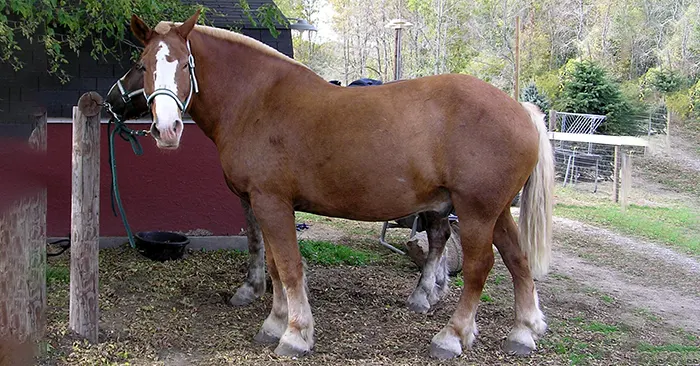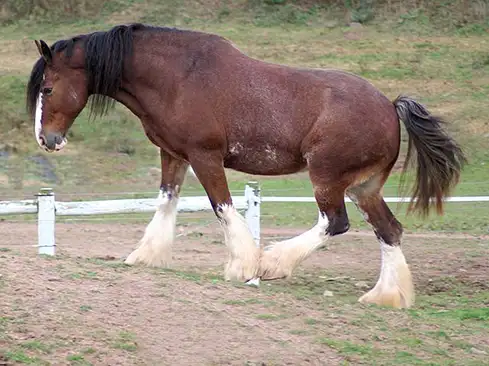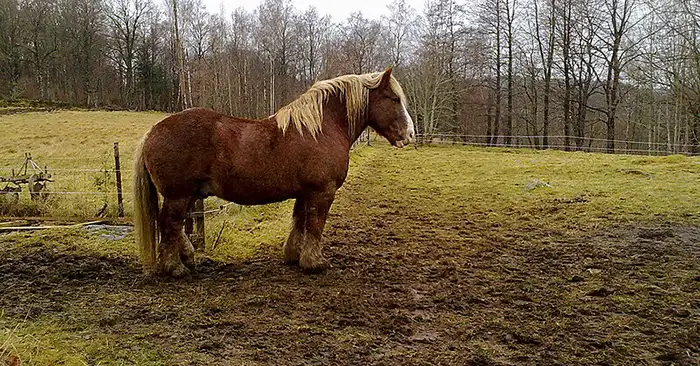The Belgian Draft Horse, also known as the Brabant or Belgian Heavy Horse, is a breed that commands attention due to its immense size and strength. Originating from the Brabant region of modern-day Belgium, this breed has a rich history that dates back to the medieval period. Initially bred as warhorses capable of carrying knights and their heavy armor into battle, these horses have evolved over time to become the gentle giants they are today. The breed’s roots intertwine with the hearty soil of central Belgian territories, particularly the once-prominent Province of Brabant. Over the centuries, the breeders of Belgians continued to produce heavy cavalry horses that could easily adapt to the climate and richly soiled grounds.
Physical Characteristics

Belgian Draft Horses are known for their massive size and immense pulling power. Males typically stand at an average height of 168 cm and weigh around 900 kg, while females stand at an average height of 164 cm and weigh approximately 700 kg. The breed is characterized by its roan coat color, which accounts for about 80% of all horses.
Temperament and Behavior
Belgian Draft Horses are often referred to as “Gentle Giants” due to their calm, docile, and friendly demeanor. Despite their physically imposing size, the Belgian has a docile and friendly temperament. They are known for their intelligence, self-awareness, and excellent decision-making abilities. These horses are incredibly patient, which makes them excellent workhorses. Their personality is ideal for farm work or carriage work in the city. They are brave and tough but also very sensitive, with an adoring temper. They are naturally curious about the world around them and eager to learn.
Health and Lifespan
Belgian Draft Horses are generally healthy and robust, thanks to their strong genetic makeup. However, due to low founder diversity, the breed is identified as likely to have a potential compromise of genetic diversity in future generations.
Care and Maintenance
Belgian Draft Horses require quality basic care that includes a veterinary wellness program with regular vaccinations, deworming, and dental exams. Due to their size, drafts often need larger stalls and turnouts than average horses to feel comfortable and safe. They are still used for all manner of draft work, including plowing, logging, pulling carriages, hitches, and sleighs. In addition, the riding of draft horses is becoming increasingly popular, in a variety of disciplines from western to jumping.
Breed’s Purpose and Use
Belgian Draft Horses were initially bred as warhorses in the medieval period, capable of carrying knights and their heavy armor into battle with ease. As the need for warhorses diminished, these sturdy animals found new purpose in farming and hauling heavy loads, contributing significantly to the agricultural and industrial revolutions in Europe and North America. Today, Belgian Draft Horses are used for a variety of purposes, from farm work to carriage work in the city. They are also increasingly popular as riding horses and pets, particularly in the United States.
The Belgian Draft Horse is a remarkable breed that combines strength, size, and a gentle temperament. Whether they’re working in the fields, participating in competitions, or simply being a companion, these horses are truly a testament to the beauty and diversity of the equine world.
References
- https://amazinghorsefacts.com/belgian-draft-horse/
- https://en.wikipedia.org/wiki/Belgian_Draught
- https://livestockconservancy.org/heritage-breeds/heritage-breeds-list/belgian-horse/
- https://horseyhooves.com/belgian-draft-horse-facts/
- https://www.horsewildlife.com/belgian-draft-horse/
- https://equusmagazine.com/horse-care/belgianprofile-10324
- https://madbarn.com/belgian-draft-horse-breed-profile/
- https://www.webmd.com/pets/what-to-know-about-the-belgian-draft-horse
- https://commons.wikimedia.org/wiki/File:Belgian_draft_horse.jpg


